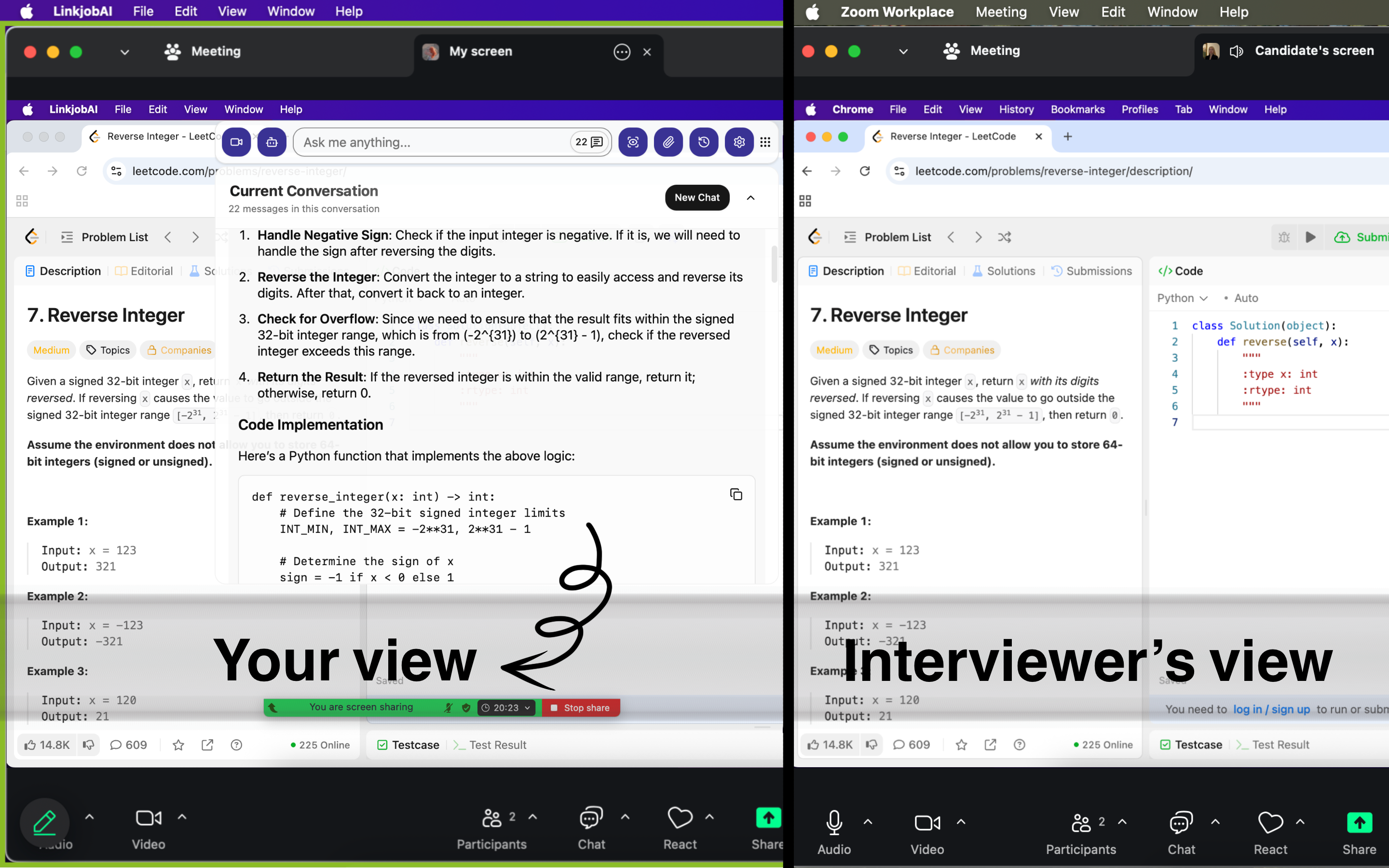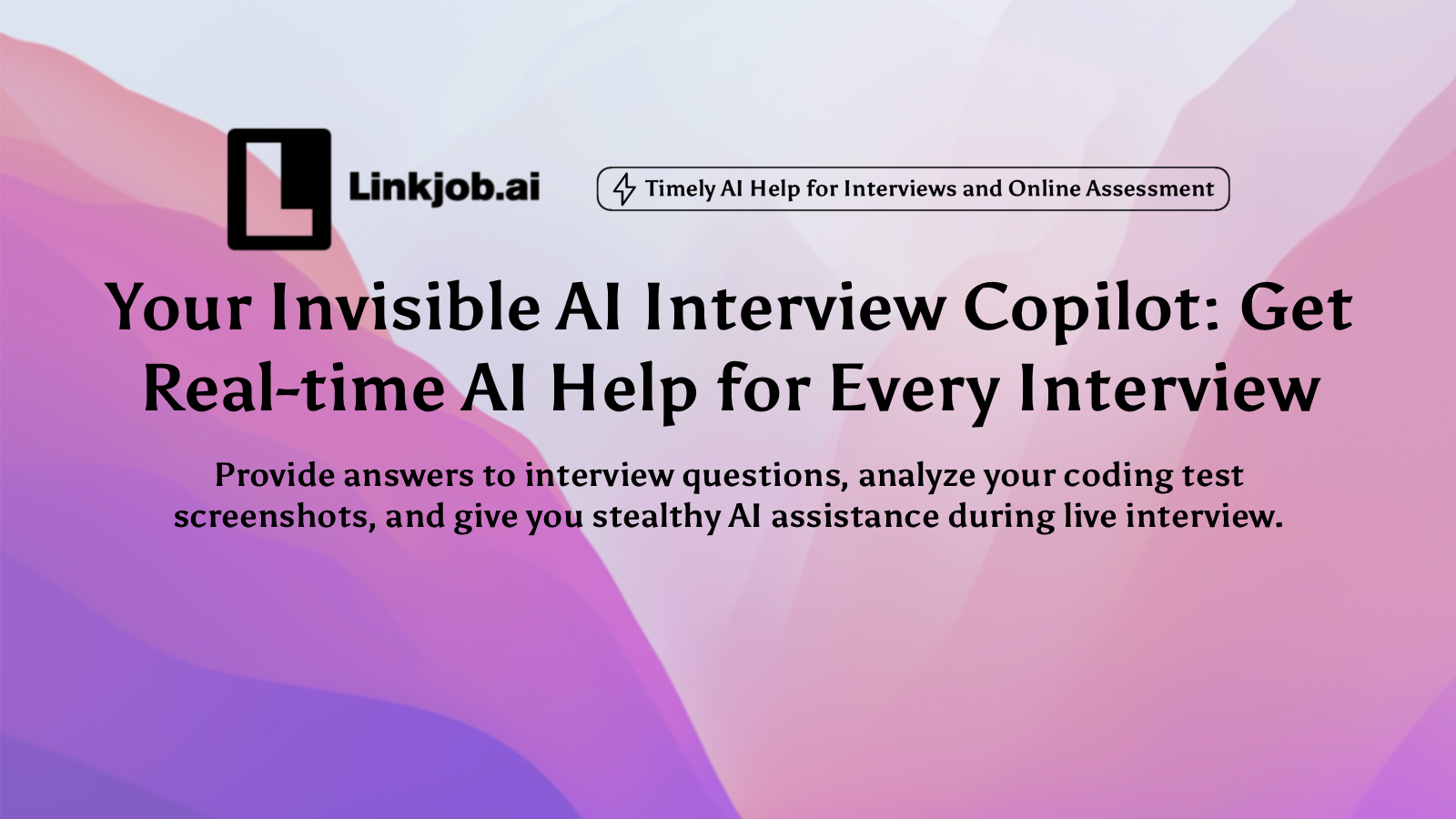My Secret Hacks For Beating HackerRank Proctoring Tools

As companies are tightening their monitoring of AI tool usage during interviews, it’s no longer possible to simply open ChatGPT and pass like before. However, there are still ways to stay undetected on meeting platforms and HackerRank. I’ve been using Linkjob AI for all my interviews over the past three months, and it has never been detected. It’s completely invisible, even when sharing the entire screen or under active tab detection.
I’m really glad to have the chance to share my experience here. Having a fully invisible AI interview assistant is incredibly convenient.
My Secret for Avoiding HackerRank Monitoring
Screen Sharing
Many coding interviews require screen sharing, and interviewers often ask how I’m thinking through the problem or how I’d optimize certain parts while I’m coding. In those moments, opening an AI tool would immediately expose me.
However, Linkjob AI takes control of system-level permissions and overlays itself on top of all apps and browsers. This means that no meeting platform or HackerRank environment can detect it, since they operate on a lower layer.
What’s more, Linkjob AI can even stay invisible in the dock, which makes me feel much more secure while using it.
I tested all these features with a friend right after installing the software, and it turned out that the AI was completely undetectable from the other side.

Active Tab Detection
The HackerRank platform can monitor my browser tabs and window activity. Frequently switching to unauthorized tabs during the test is considered a violation and may be flagged as using external AI assistance to cheat.
However, Linkjob.ai is specifically optimized for this scenario. It doesn’t rely on a web interface but runs as a standalone desktop application, making it completely undetectable by active tab monitoring. It also eliminates the need to switch pages during the interview.
Moreover, Linkjob AI leverages system-level permissions to prevent screen monitoring. So all I need to do is start it before the interview. It will automatically read what’s displayed on my screen and generate responses in real time.
Webcam Monitoring
Some coding interviews and HackerRank tests require me to turn on my camera. In those cases, my facial expressions and eye movements are visible. If my eyes frequently drift away from the screen or my expressions don’t match the test’s pace, it could easily suggest that I’m using AI assistance.
However, with Linkjob AI, I can reduce the transparency of the answer panel and drag it directly over the interview question. This way, when I glance at the AI-generated answers, it looks as if I’m simply reading the question. As shown below, I can freely adjust the panel’s transparency and position it wherever it feels most natural.

Clipboard & Keyboard Behavior Monitoring
HackerRank tracks my keyboard operations and clipboard usage. Frequent Ctrl+C and Ctrl+V actions, or abnormal keyboard input rhythms (such as sudden large-scale code entry after a long period of inactivity), will lead the system to suspect that I'm using external tools for assistance.
However, this problem is also the easiest to solve. I just need to manually type in the code based on the AI-generated answers. The only thing to keep in mind is to control my typing pace, and slow down appropriately on the more difficult parts. Then, I can submit my answers at a reasonable time.

Step-by-Step Guide to Coping with HackerRank's Detection
Capture Live Screenshot
Coding interview questions often come with long, complex prompts. Copying them manually into a general AI tool like ChatGPT can be very tedious. But with Linkjob AI, I can simply take a live screenshot and get instant AI answers. If one image isn’t enough, it supports up to six screenshots per batch.
Each answer includes a detailed solution approach and copyable code output. However, I still recommend typing the solution manually to stay safe, rather than copying it directly.
Attach Images / Upload File
When capturing the whole screen isn’t ideal, this feature lets me upload a specific portion instead. It helps the AI better understand the context of the question without being distracted by unrelated screen elements.
Still, I mostly rely on the capture live screenshot feature, while this one is just a useful supplement.
Streaming Conversation AI Copilot
This feature is perfect for interactive coding interviews, where the interviewer asks follow-up questions as I code.
The AI automatically detects when the interviewer speaks and streams answers in real time, no need to manually start or stop listening. That allows me to focus entirely on understanding the questions and responding naturally with AI-assisted insights.
Personalized Service
To make AI responses more tailored to my real situation, I uploaded my resume, target positions, and companies. Before each interview, I fine-tune my AI prompt to ensure the output matches my tone and background. As a result, every response feels personal and authentic, like having a smarter version of myself sitting in the interview.
FAQ
Will HackerRank's monitoring system identify "perfect code" as AI-generated answers?
This situation is very likely to occur. However, Linkjob AI generates answers using APIs of mainstream AIs such as ChatGPT, Gemini, Cloud, and Grok, and these AIs will mimic my coding habits, thus completely avoiding this situation.
Besides HackerRank's OA, can I also use LinkJob AI in other rounds of the interview?
Of course you can. In my recent interviews, I used LinkJob in every round. It can not only see my screen but also hear the audio from my system. That is to say, it can catch the questions the interviewer asks me and generate real-time answers based on my personal situation and the position I am applying for.
Moreover, it can help me respond to the interviewer's follow-up questions in a timely manner. This is a highly practical feature that I have never seen in any other AI tools I used before.
See Also
Techniques for Leveraging Technology in CodeSignal Exams
Using AI Discreetly to Succeed in Microsoft Teams Interview
Exploring AI Tools for Effective Interview Preparation
How I Passed the Microsoft HackerRank Test in 2025 on My First Try

